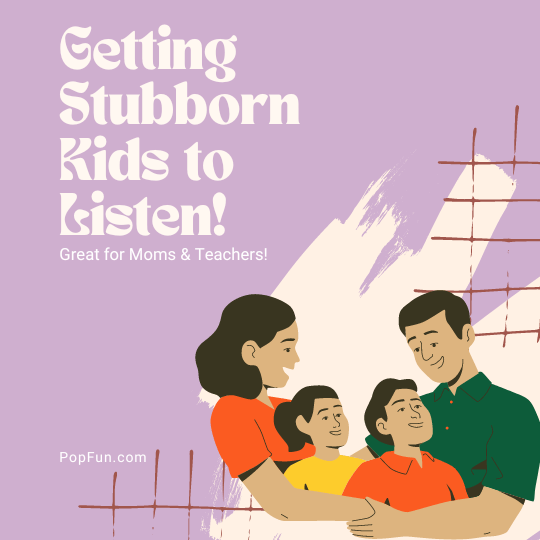Your Cart is Empty
Getting Stubborn Kids to Listen
November 08, 2022 10 min read

How familiar does this sound? "Well, he kept crying and crying so I just ended up giving him back his video game. I mean, I didn't want to make a scene. But it was just this time. I won't let him get away with it next time!"

New Parent? You're in the Right Place
I'm so sorry. It sucks when you're in public and people stare and judge your parenting abilities. Kids cry for a variety of reasons, yet their dirty glares suggest that you're the one to blame. We're here to assure you that it's a lot more complicated than that. In fact, there's a whole subfield of psychology called "behavior sciences" yet we still have so much to understand about children. We hope this article not only helps you feel better, but also gives you the tools you need to better your communication with your child.
Before we start, I'd like to introduce myself! I'm Ellen from www.PopFun.com, and I graduated with my Bachelor's Degree in Psychology from UC Irvine and obtained my Master's Degree in Behavior Sciences from Pepperdine University. I've worked with kids who have autism for 3 years, both in school & home settings. I hope you enjoy! If you have any questions, you can always email me at socialmedia@popfun.com. I love questions on behavior psychology! ❤
Understanding the 4 Functions of Your Kids' Behaviors
Knowing the function helps. Big time.
The first step in identifying WHY your child is behaving the way they are is the FIRST and most IMPORTANT step. To the left, you can see that we have escape, attention, access, and automatic. Although it might seem pretty self-explanatory, let me explain a little more in detail about what this all this behavioral psychology jargon means.
Keep an open mind while reading this-- we don't know your chid, after all. Preferences and behavior functions can switch in a matter of seconds!

Escape
Escape behavior is exactly what the word is: ESCAPE. Although "escaping" could mean a multitude of things to you, here, we are talking about escape from the activity or task.
Fun fact: Although some people chuckle at this word, registered behavior technicians actually label this physical escaping behavior as "elopement." It is commonly known as such in the Applied Behavior Analysis world!
So basically, this is whenever your child literally runs away from you, turns his head away in refusal of eating the food you worked so hard on, fake sleeping, or putting his head down on the desk in refusal to do homework.
Anything aversive, anything that they dislike could cause this behavior to occur.
i.e. Sorry Mom, but they hate your home-made pasta. EW. They run off.
i.e. Maybe if I pretend to sleep they won't make me do the chores. Zzz.
Anything that is more reinforcing could also cause this behavior to occur.
And this is tricky, but it could also be paired with another function of behavior, such as attention. Maybe they run away to get your ATTENTION, or they run away because then they get ACCESS to free time. Tricky, huh?
Tips on Preventing Escape
- If they tend to run away before they finish their homework, place them into the corner of the room and sit in front of them. You and the table should be a good cornering mechanism.
- Tailor the environment so that there are less distractions. This is a great time to tidy up.
- Create an activity schedule so that they know EXACTLY what is next, and for how long they have to sit.

Attention
Ahhh, the good old LOOK AT ME!!!!!!!!
This is one of the more "popular" behavior functions out of the 4. This could look like aggression (i.e. smacking family & friends), screaming, crying, property destruction, cracking jokes to get their peers laughing, eye contact, and more.
Unfortunately, if your kid is a future Leonardo DiCaprio kind of a great actor, the believability of their whining and attention-seeking behavior could actually trick you and cause you concern. However, it is not just concern that is attention. Reprimanding your child and telling them "NO" is something that counts as attention, too.
I'm serious-- know the function, and you'll know how to respond. We'll go more into depth on how to respond!
Tips on Attention
- Don't look at them. This is the number 1 mistake I saw while managing therapists! I know this is hard to do, and it's inevitable, you are trying so see what they're up to... but this is exactly what they want.
- Don't say their name. Whether you say it kindly or angrily, this is ALL considered ATTENTION!!!!!
- Don't touch them. Touch is still a form of attention. Simply walk away if you need to.

Access
Sounds like: "GIVE IT TO ME!!!!!! I WANT IT!!!!!"
This behavior for access arises to obtain access to tangibles or activities. When paired with escape, it gets really tricky! They'll use any reinforcer (toys, things they prefer, food, etc.) they see as an excuse to escape the task.
If you misidentify it as only access, you're teaching them that getting distracted by the environment, changing the topic, and asking you for things OTHER THAN the task at hand will give them a lot of time away from the task.
When you misidentify it as only escape, you're teaching them that whining gives them access.
What might that look like?
Misidentifying as only access can look like negotiation!
Setting: Room
Task: Homework
Kid: "I WANT MY BUNNY!!"
Mom: "Later, do your homework."
Kid: "But Mom, I really want to have my bunny next to me..."
Mom: "No"
Kid: "Please????"
...and so on. Because by this point, your kid has ALREADY successfully escaped the task for a good few minutes, negotiating, pleading, whining, and challenging the rules to the task at hand. Be one step ahead & know exactly WHY they're doing what they're doing!
Misidentifying as only escape can look like lying disguised as a legitimate excuse:
Setting: Room
Task: Homework
Mom: "Do your homework."
Kid: "NoOoOoOo I have to go to the bathroom!!"
Mom: "Ok, go quickly."
Kid: *RUNS OFF TO THE SWINGS IN THE BACKYARD*
...yup. And then it takes them another 10 minutes of negotiating to get them back inside. 😅😐
Tips on Access
- Use the Premack Principle, also known as "Grandma's Rule": "FIRST ______, THEN _______." Concise instructions are a much more effective discriminatory stimulus/demand.
- Activity Schedule: Let them know exactly when they will have access to whatever they're trying to have access to.
- Set TIMERS. Timers are incredibly effective visual stimulus to let kids know when to hold out. Remind them of how much more time they need. Allow them to press the start timer and set the reward for when the timer rings! Fade out the rewards over time. They should not be doing work solely for the rewards.

Automatic
Automatic is the need to fulfill a sensory need or an automatic, bodily response, like going to the bathroom.
The automatic function is going to the bathroom, drinking water after eating something salty, the satisfaction of washing your hands after they're dirty.
Some children who may have autism may rock back and forth, flap their hands, skin pick, or make new/repetitive sounds to fulfill their sensory needs. These behaviors require a BCBA to set up a treatment plan that will best replace any harmful or socially inappropriate behaviors.
Tips on Automatic Sensory Needs
- Satiate kids' needs beforehand
- Use automatic needs as reinforcement: For example, if my goal is to teach them to use a straw, I will give them salty Goldfish so that they will be motivated to drink water through the straw to satisfy their automatic needs.
- Activity schedule: Give them the exact schedule so kids know exactly when they can satiate these needs and plan accordingly / beforehand
Knowing How to Respond to Your Kids
How will you know that you're doing these 5 things? It's important that there is someone to do the same thing to YOU as well. It takes major practice to respond in these ways, WELL and CONSISTENTLY. To give you a good perspective so that you're not so hard on yourself, Registered Behavior Technicians have 40 hours of training and still struggle with concepts & responding correctly EVERY SINGLE TIME. Therapists need to go through masters programs and yet the live scenarios is never like what the books tell you.
You are not a bad parent if you can't do all 5, or can barely hit 1 of these tips. Every family, every child, every situation is different. I'm here to provide some tips, but take it all with a grain of salt, love. You're pretty amazing if you read this far, too! 😚
P.S. I highly suggest an assorted toy box when you are working with your students or your children. I suggest Wind Up Toys, Sensory Slugs, and Fidget Toys! Good for motivation & kids whose preferences change quickly.

01 Consistency is Key
There is a type of reinforcement called INTERMITTENT REINFORCEMENT. It is the bane of all therapists' hard work!
This looks like OCCASIONALLY giving in, or OCCASIONALLY following through with your demands.
Example: If your kid wants a toy in the store, SOMETIMES, if they whine hard enough, they might get that toy. "Mom might just cave if I give her puppy eyes or promise her empty promises!"
When I say consistency, make sure that your kid understands that your response will be the same. When you are firm and follow through, the probability of the kid begging and using the same behaviors will go down. DO NOTE that when you begin to follow through more, there will be an extinction burst.
What's an extinction burst?
An extinction burst means that the targeted behavior rate will TEMPORARILY SPIKE in the other direction. For example, if you want your kid's screaming duration to decrease, it will temporarily INCREASE before it decreases to 0.
Below, you can see that baseline describes the kid's screaming duration before any therapy. After the phase line, you will see that after the behavior plan was implemented, both the level and rate increased. Then, it rapidly fell to a level lower than the baseline.

02 Positive & Negative Reinforcement
Let's break it down!
➕Positive - the ADDITION of a stimulus
➖ Negative - the REMOVAL of a stimulus
Reinforcement - the likelihood that the target behavior will be increased or strengthened.
A lot of people misunderstand that "positive reinforcement" is synonymous to "anything good" when really, it is not. Yes, high fives, social praise, and all of these good things are considered "positive" in terms of mood and feeling, but in this sense, "positive" describes the ADDITION of a STIMULUS. Remember, this stuff is scientific, no feelings! 😝
On the other hand, negative reinforcement is the removal of a stimulus to increase the likelihood of a particular behavior increasing. For example, opening an umbrella on a rainy day. You are REMOVING the stimulus (rain) to increase the likelihood of you staying dry. If it works (let's hope there aren't any holes in your umbrella, haha!), you'll most likely do it again.
So how does this apply to getting your stubborn kids to listen? 👀
Both types of reinforcement should happen IMMEDIATELY after their response. The more immediate, the more effective it is. Reinforcement should also be very enthusiastic and frequently. I could go into reinforcement schedules and intervals, but that's a topic for another time!
All in all, do it quickly to pair their behavior and your consequence together. If you are using food to reward them, you don't have to worry about over-feeding them if you are delivering these edibles in tiny bits and pieces! But make sure they are LARGE enough to be a reinforcer. If they're too small, they're going to lose interest pretty quickly.
Also, do be aware that preferences can change quickly. So have plenty of options ready at hand, nearby, but out of their reach.
03 Positive and Negative Punishment
Here, "positive" and "negative" mean the same thing as they do in reinforcement.
Just to recap:
Positive means the ADDITION of a stimulus, and negative means the REMOVAL of a stimulus.
Punishment here does not mean "abuse" or "harm." This is commonly mistaken as such.
➕ So what is positive punishment?➕
If you add more chores to your child's list when they neglect their responsibilities, this is adding stimulus to decrease the likelihood of them forgetting their responsibilities.
➖ And what is negative punishment?➖
If you take away the cookies they stole along with their favorite stuffed animals, you are REMOVING stimulus to decrease the likelihood of them stealing those cookie again. They'll lose cookies AND their stuffed animals? Heck no!! It's not worth it for them anymore.
How does this apply to getting your kids to listen?
Well, it works if you are positively paired with your child. You're probably thinking, I'm not paired with my kid? I gave birth to them! HOWEVER there are some kids who don't see their parents often, or associate their parents with hard work and aversive things like homework and chores. Make sure that you do have a good relationship with your kids so that the demands you give them don't have to resort to punishment all the time. In fact, in clinical ABA (Applied Behavior Analysis, in case you forgot!), therapists deliver reinforcement ONLY. Many companies do not believe that punishment and other forms of controversial "behavior modification techniques" are even effective at all for kids.
04 Kind But Firm
This one's pretty straightforward... be kind to your kids. Kindness goes a long way. Being calm is mutually exclusive to being aggressive, heated, emotional, and impulsive. Being kind is being loving, too. Kids can feel it!
Raising your voice can sometimes be inevitable. No one-- you and your kid-- are not listening when voices are raised and emotions are heated. Set a good communication example for them. It's difficult, but it's still possible to be a great role model for them.
Saying you kids' names in a snappy way to get their attention 100 times in a row can also be inevitable. But please refrain from this. First of all, calling their name too many times can also decrease the likelihood that they will respond. Second of all, saying it in a snappy way can make them associate you calling their name at all for ANY reason as an "uh oh" moment. Does this remind you of your scary boss? The one who ONLY calls you in to reprimand you? Yeah. You don't want to be a scary parent, or their scary boss. Hard, but doable.
Create fair standards & boundaries. Be an AUTHORITATIVE parent, rather than an authoritarian, permissive, or uninvolved parent.
05 Catch Them Doing Well
This builds off of 04 Kind But Firm.
The more you are kind and reinforcing, the more you will pair with them. If you are always catching them doing something wrong, they will associate your presence with "did I do something wrong?" and I don't know about you, but I think that'd be incredibly sad. By the time you actually want to help them, your relationship with them has already gone downhill. They won't open up to you about things you need them to.
So start early, and reinforce them-- immediately & enthusiastically. Reinforce good behaviors. Be consistent on follow through and show that your standards and rules are reasonable so they should not be bent or changed in any way.
Don't forget-- kids toys are essential for motivation. Read my other behavioral sciences-based blog on why kids toys are important!
Click HERE!

WANNA COLLAB?
Click HERE to Apply 🌈❤️✨
Halloween is the perfect time for social media collaborations!
Send us your media kit and introduce yourself, or email us at socialmedia@popfun.com
We'd love to discuss our incredible affiliate program with you. Let's work together and give kids a wonderful childhood.

Follow us to get answers & inspiration
Social Media 😃
Don't forget to subscribe to our PopFun LinkTree! You can sign up for email & SMS news.
Leave a comment
Also in PopFun Blog Posts

Revolutionizing Toy Shopping: An Introduction to Our New ChatGPT Plugin
June 19, 2023 3 min read 3 Comments

Wallpaper Wonderland: Downloadable Aesthetics for Every Taste
May 23, 2023 7 min read
Discover Wallpaper Wonderland: an immersive collection of downloadable aesthetics for every taste. In this era of personal expression, our wallpapers go beyond mere backgrounds, serving as artistic statements. Immerse yourself in captivating landscapes, minimalist patterns, and carefully curated collections that cater to nature enthusiasts, modern art lovers, and fans of vintage charm. Each wallpaper evokes emotions, be it serenity, inspiration, or vibrant energy, bringing joy to your digital experience. Transform your screens into personalized works of art and embark on a visual journey through our Wonderland, where every taste finds its perfect aesthetic match. Welcome to Wallpaper Wonderland.

Off-Season Halloween Decoration: Spooky Savings at Great Prices
May 18, 2023 3 min read
Unleash the thrills of Halloween all year round with our off-season sale on spooky decorations! Discover incredible prices and unbeatable value on the Cocooned Skeleton, Witch Legs Lawn Lights, and more bone-chilling delights. Transform your home into a haunting haven without breaking the bank. Don't miss this opportunity to grab these spine-tingling deals and be prepared for the next Halloween season ahead. Shop now and save big on frightful fun!



